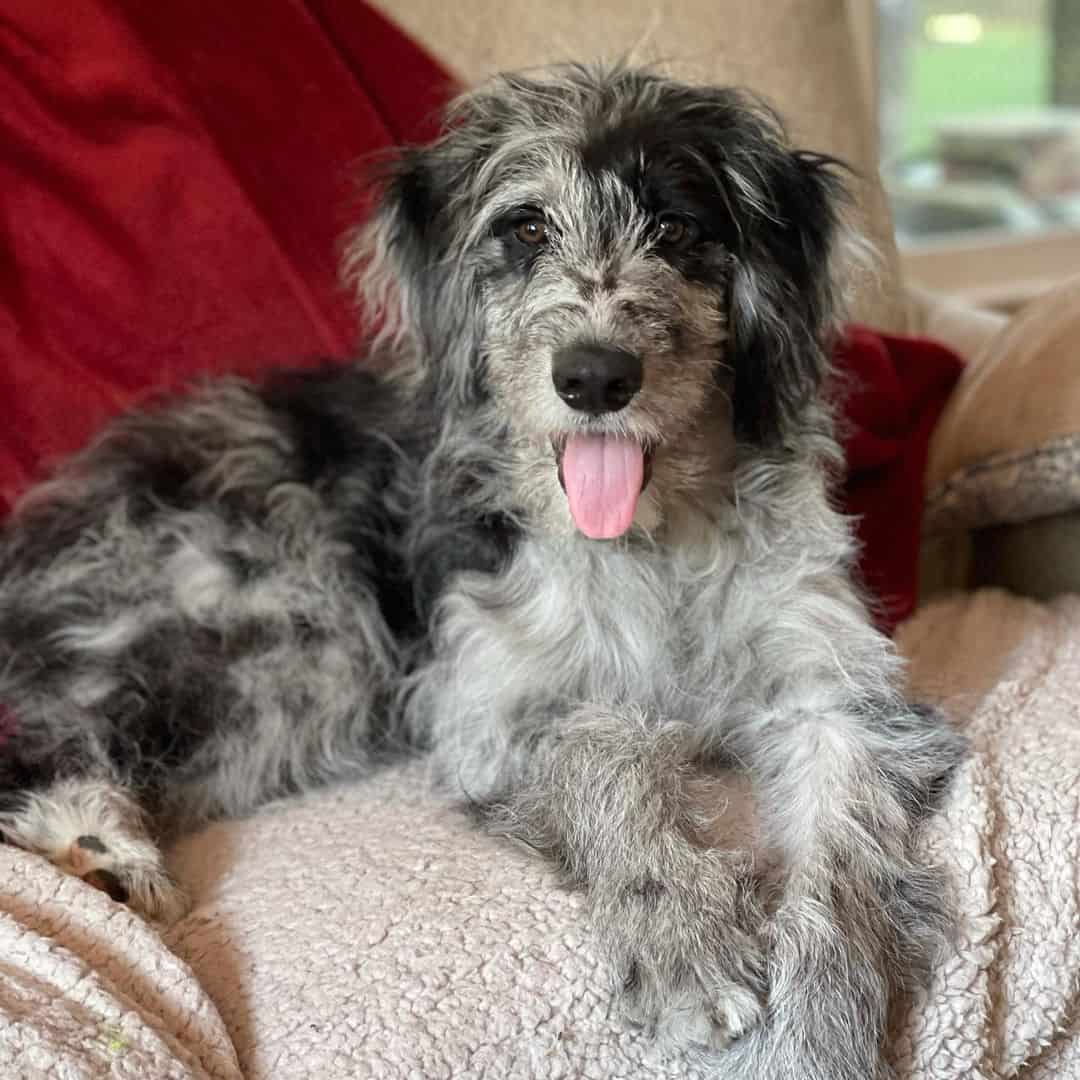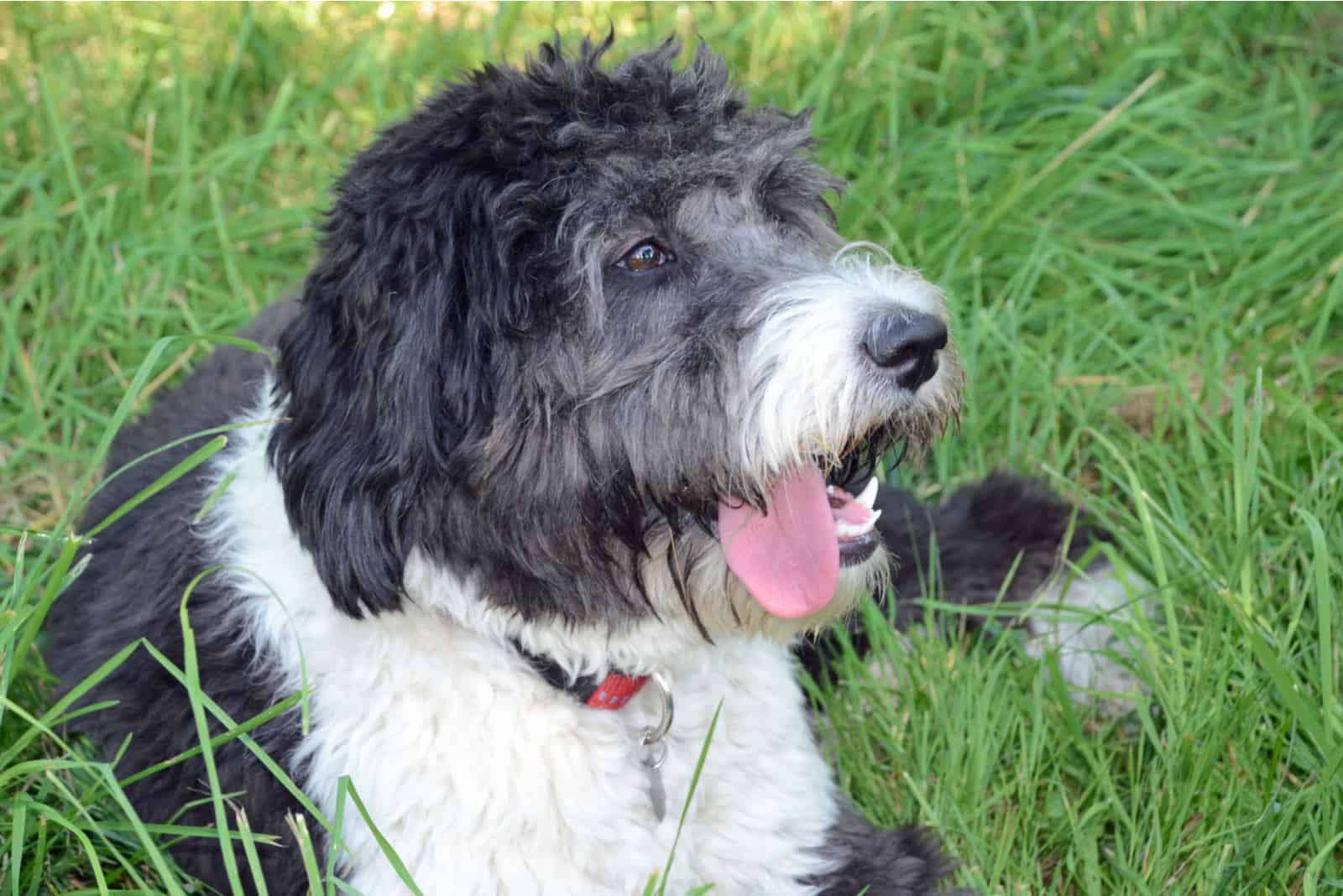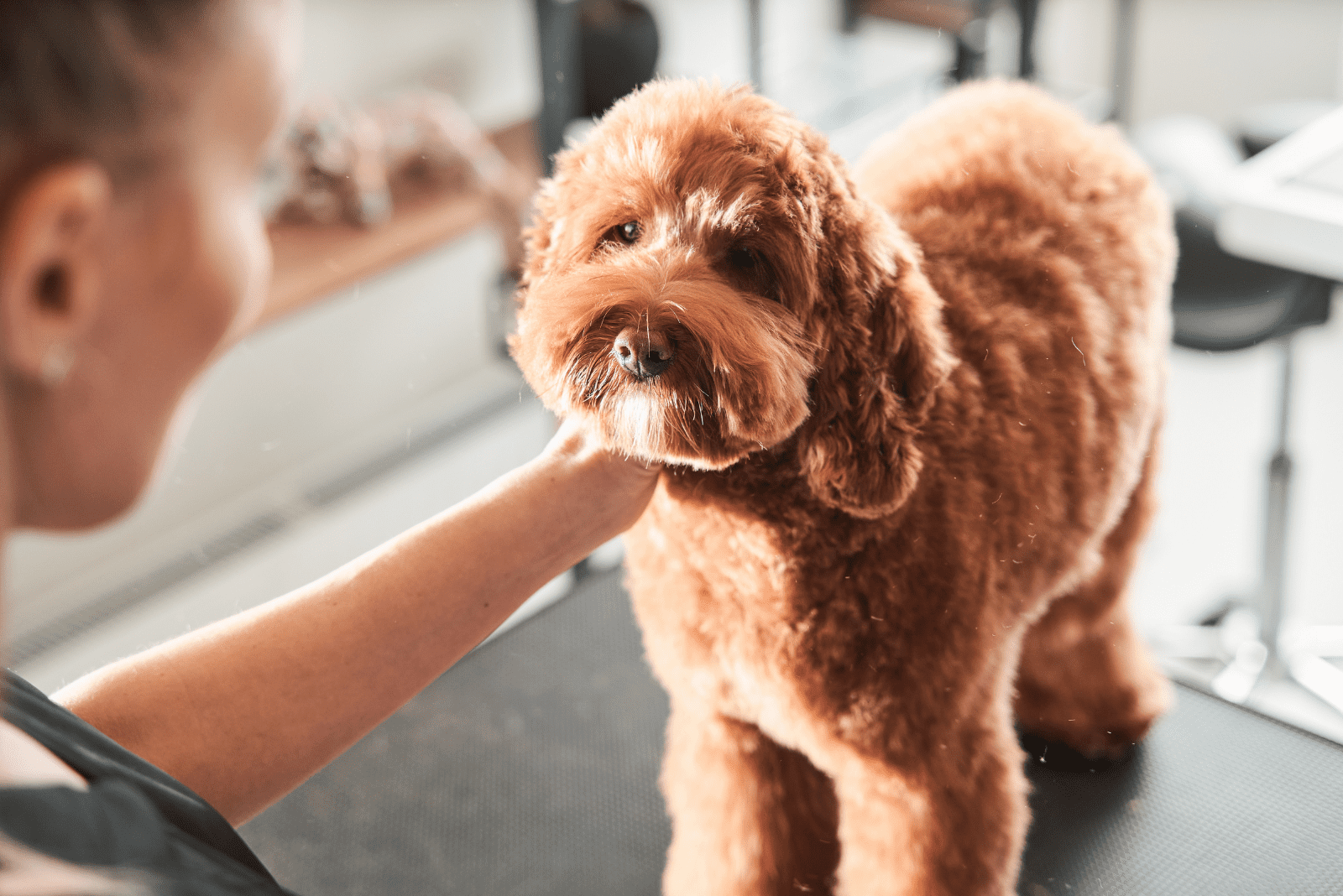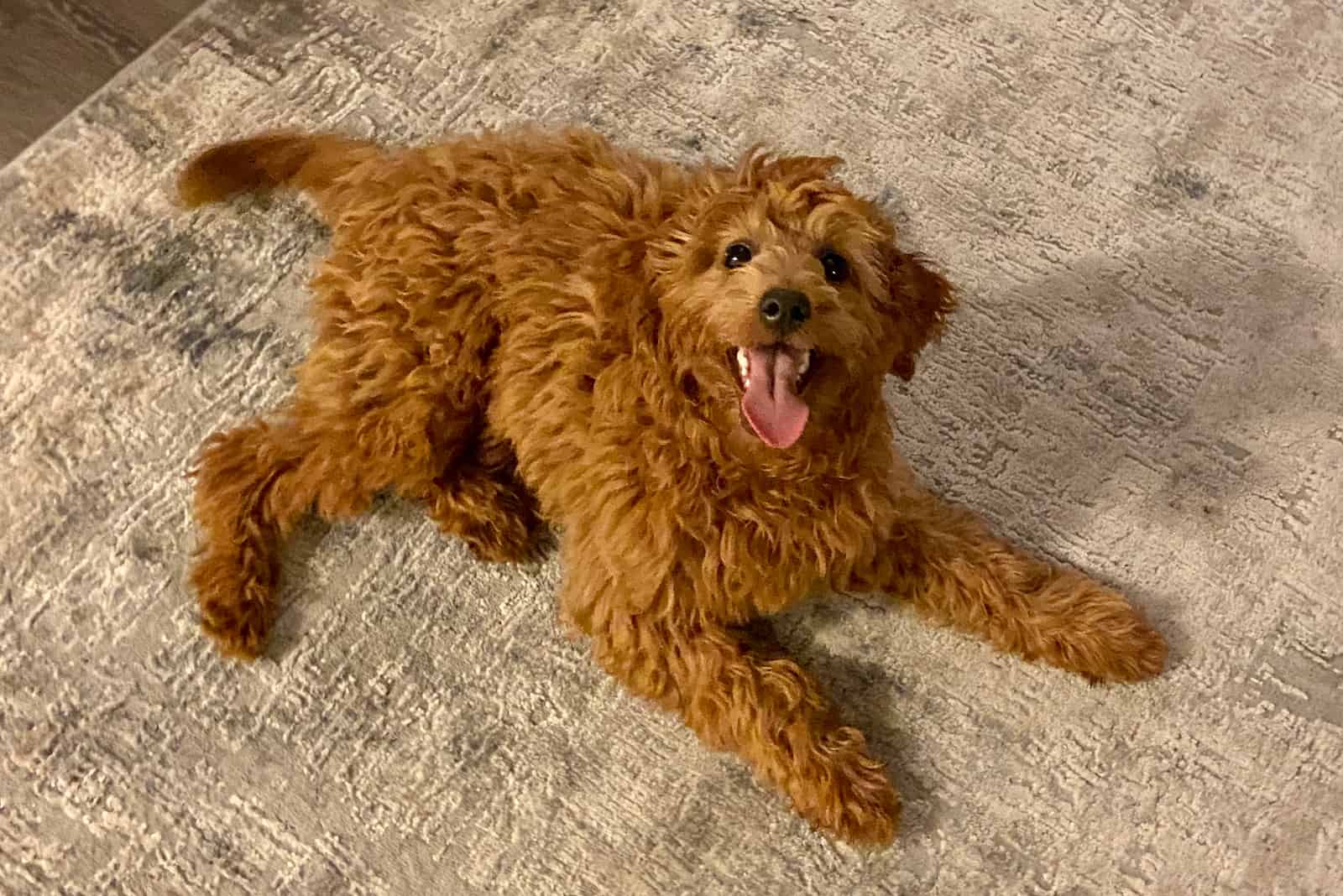Owning a dog is wonderful!
Playtime together, endless amounts of wet kisses, a loyal companion by your side… And if you own an Aussiedoodle, things couldn’t get better!
But then that loyal companion starts to shed. Everywhere. Wait a minute! Do Aussiedoodles shed?
Aussiedoodles, like all other dog breeds, do shed. But, the question is: how much?
There’s no way to stop the shedding completely, but there are ways to reduce it.
Today we’re going to teach a beginner to grooming (YOU) on how to take care of your Aussiedoodle and keep that teddy bear coat nice and shiny.
Got your brush? Good! Let’s get brushing!
A Brief History: What Are Aussiedoodles?

Crossing dog breeds to get one perfect exemplary type is what dog lovers have been doing for the past few decades.
The whole point of crossbreeding is to achieve a certain look, temperament, or ability.
Such breeding was also the starting point for many popular breeds, including the Australian Shepherd.
Crossbreeds have become popular over the past two decades. The most popular ones have the Poodle as one of the purebred parent breeds.
It’s their hypoallergenic trait and overall good health status that makes these pooches so appealing.
The Aussiedoodle mixed dog breed‚started back in the 1990s or early 2000s by mixing a Poodle and an Australian Shepherd.
Since the Poodle can come in three sizes (standard Poodle, miniature Poodle, and toy), the Aussiedoodle may come in three sizes too!
What we know about the origin of the Aussiedoodle is very meager. Luckily, we do know about the parents.
The Australian Shepherd or Aussie is a very popular dog breed; the 17th most popular out of 193 AKC registered breeds, to be precise.
Surprisingly, these dogs weren’t first found in the land down under. The first Aussies were found in the 19th century in South-Western America.
It’s their ancestors who came to the USA via Australia.
The Poodle is a bit older, with the breed originating from the French and German border in the 15th and 16th centuries. Poodles, or water retrievers, were quite popular hunting dogs.
It’s their one-of-a-kind look that made Poodles popular later on. The toy and miniature Poodle were both bred from the Standard Poodle by using the smallest puppies from each litter. The USA saw these pups first in the 20th century.
Keeping in mind how long ago their parents got to America, we can say the Aussiedoodle was a creation that started twenty years ago.
We’re only sorry the world didn’t get to see these wonderful pups before. They make excellent therapy dogs for people in need, loyal sidekicks, and beloved family members!
The Aussiepoos’ easy trainability is what makes them terrific first dogs.
What’s The Aussiedoodle Coat Like?

Aussiedoodles, like all other crossbreeds, vary in coat color and style. There are no identical Aussiedoodles. Even the coat quality between puppies in the same litter can be different.
Most puppies will have wavy hair, with some straight and tightly curled parts.
Still, the coat may fall anywhere on the curly side.
As for the coat coloring, not many dog breeds have the number of color variations that the Aussies do. The most common varieties are:
• black and white
• red and white
• cinnamon merle
• red merle
• blue merle
• chocolate
• chocolate and white
• tricolor
• red sable
• black and tan
• silver
• cream
There are a dozen coat colors an Aussie can carry. There’s no way you won’t be able to pick one right for you!
See Also: About The Golden Aussiedoodle: Everything You Wish To Know
Are Aussiedoodles Hypoallergenic?

Let’s clear things up: there’s no such thing as a 100% hypoallergenic dog.
There can be low-shedding dogs like the purebred Poodle, but no non-shedding ones.
When a Poodle mixes with another breed, in this case, the Australian shepherd, we’ll get a healthy pup with low shedding probability.
Unless you or someone from your family doesn’t suffer from highly severe allergies, an F1 Doodle could be your choice as they shed little and appear not to trigger allergies.
Of course, this isn’t a hard and fast rule, so we can’t guarantee your Aussiepoo or Bernedoodle won’t shed.
As a rule, short-haired pups are a nightmare when it comes to shedding and dander falling out everywhere. Long-haired pooches handle this situation better.
However, those of you who are prone to severe allergies might want to check out the F1B Doodle if you still want to ride the Doodle train.
Spend some time playing with a first generation pup to see if your allergies will be set off.
To answer the question about the hypoallergenic trait once and for all…
The level of hypoallergenic features depends on the severity of the allergies. Sometimes the pup might look like its dad, sometimes like its mom, or even both! The same goes for carrying the allergy-triggering traits.
See Also: F1b Aussiedoodle Vs F1 Aussiedoodle: What’s The Difference?
General Overview: How Healthy Are Aussiedoodles?

There are no dogs who don’t face health problems at some point in their life. Generally, Aussiedoodles are a healthy dog breed unless you count some severe genetic disorders they can inherit. Such disorders are:
• Cushing’s disease
• cranial cruciate ligament rupture
• epilepsy
• hip dysplasia
• ivermectin sensitivity
• pancreatitis
• progressive retinal atrophy
Cushing’s disease results from hormone-secreting tumors of either one of the brain’s pituitary glands or the abdominal adrenal glands.
These glands produce excess cortisol, aka the stress hormone. Cortisol has been seen in middle-aged dogs due to a hormone-secreting tumor of either the brain’s pituitary gland or the abdominal adrenal glands.
The excess produced cortisol has extensive effects on the body, meaning the dog might be prone to weight gain, exercise intolerance, increased appetite, hair loss, and skin pigmentation disorders.
Cranial cruciate ligament rupture means weaker stability in the knee joint due to the degeneration of ligament fibers. Symptoms usually occur after a small trauma, e.g., landing badly after a jump.
The best way to cure this condition is to go with the surgery and regain normal joint function.
Epilepsy or convulsions are alterations in consciousness dogs might experience as early as six months of age.
The infrequent seizure activity still allows dogs to lead a normal and happy life without being on meds.
Hip dysplasia is an inherited joint disease that affects the hindlimbs. It’s an inherited developmental disorder of the hip joints that causes hindlimb lameness.
Some puppies seem to grow out of the problem, while others are more likely to develop osteoarthritis.
An Aussiedoodle puppy with this disorder shouldn’t be used for breeding.

Photo from:@bentleytheaussiepoo
Ivermectin sensitivity is a condition that prevents the entry of medications to the spinal cord and brain, causing a severe reaction to certain drugs, e.g., Ivermectin.
Any Aussiepoo who is using this med should be tested and evaluated beforehand.
Pancreatitis is an inflammation of the pancreas, a digestive organ that sits along the stomach wall. This condition can cause abdominal pain and vomiting.
Dogs prone to consuming high-fat food, meds, or those who experienced some trauma are possible patients.
Overweight dogs are the most commonly affected ones and they should be treated with intravenous fluid therapy and fed an ultra low-fat diet.
Progressive retinal atrophy represents inherited blindness common for both parent breeds. All adults should be tested to see if they carry this gene. If so, they must be removed from the gene pool.
Now that you know what an Aussiepoo’s health problems might be, it will be easier to spot and prevent them.
What Are The Different Aussiedoodle Coat Types?
The Poodle parent is responsible for the two types of coat: curly and wavy. Out of these two, it’s the curly hair that’ll give you more of a headache and requires more grooming than wavy hair.
The reason behind the extensive brushing is that the curly coat can become easily matted. Daily brushing is recommended to keep the curls clean and bouncy!
The wavy hair is usually the result of having the Australian Shepherd in the gene pool. Wavy hair is longer and requires less attention. Although, the owner must still brush his wavy-haired Aussiedoodle once a week or every two weeks
This is a dog breed that possesses a single coat. So, there is no undercoat that would push forth loose hair. Once again, thanks, Poodle! We owe you big time!
Can Shedding Be Connected With Different Health Issues?

Yes, shedding can be connected with different health issues.
Take anxiety for an example!
We often forget how dangerous anxiety can be. It even causes shedding in Aussiepoos, especially when it comes to boredom or real anxiety.
Anxiety causes extensive licking, chewing, and scratching that can irritate the skin and leave your dog hairless at some point.
Boredom anxiety is easier to treat. It simply takes you to have fun with your pup! Gather your family members, get in the car, and go for an adventure!
Well, at least go to the doggie park. This way you’ll trigger the dog’s mental stimulation and still exercise it.
Dog sports like throwing a ball or catching a frisbee are always great ways to face anxiety. This way you’ll help your dog get that much needed exercise and it gets to spend time with you, which is always a bonus.
Time spent in the park isn’t that harmless. There’s always danger lurking. In this case, the creepy crawlers such as fleas, ticks, and other parasites can make their way under your dog’s fur.
These tiny creatures will cause itchiness and skin irritation.
This means the dog will over-groom himself more than is recommended, scratch and make scabs and wounds. Nobody wants that! Open wounds invite infections and complicate the situation even more.
The next time you decide to visit the park, use products designed to repel parasites and ticks.
There’s a range of products available, from sprays, to drops, and collars, that can prevent ticks and other critters from attaching themselves to your dog’s coat.
No those bug sprays aren’t a marketing ploy. You really need them when going out with a cutie like your Aussiedoodle!
Poor Diet And Shedding: Is It Related?
Absolutely!
Poor diet is one of the biggest and easiest causes of shedding. The hair gets easily broken and becomes weak. It needs vitamins! Poor feeding habits are the root of many health problems!
Luckily, this problem can be overcome easily if you just increase the quality of the dog food you’re buying. Your pup will have a nice, shiny, and healthy coat, and receive a nice boost from the high energy level.
Dog food should be rich in omega-3 fatty acids. This supplement allows the dog to grow big and strong while the coat becomes thick and lustrous! Naturally, the best source of omega fatty acids is in raw food.
It is absolutely fine to give your dog a can of tuna or salmon, or even fresh sardines. Scallops are also a good idea, but fish sticks are off-limits.
Salmon, chicken, and beef have the highest zinc reserves. Zinc is a high-quality mineral that stops itching, and skin inflammation.
Besides needing zinc and omega fatty acids, your dog’s body needs protein too! Meat isn’t the only source of protein. Eggs are an even better choice, no matter how you prepare them! Also, edamame is surprisingly rich in protein.
How Much do Aussiedoodles Shed?

Aussiedoodles are low shedders thanks to their poodle parents.
Of course, there are factors that might increase the shedding level. That’s why it’s important for you to learn all the shedding triggers your dog can experience.
Still, with regular light grooming there won’t be balls of hair flying around the place.
There are multiple causes for shedding in Aussiedoodles.
Thanks to the Poodle side of the family, the Aussiedoodle is a low-shedding pup. The tight curly hair traps shedded hair underneath the coat where they’ll stay until you brush it out. Once this messy situation is solved, you’ll notice no more shedding.
You’ll be thankful there are no seasonal blowouts like some dogs experience. Once again, all thanks to the Poodle parent who provided the genetic code for a low-shedding pup with curly hair and a single coat.
The puppy coat will be long gone when the Aussiedoodle reaches the stage of an adult dog. This means the low-shedding feature will still be there.
Great news for those who hate vacuuming! Frankly, who even likes it?
How To Face Aussiedoodle Shedding

The biggest part of dealing with your Aussie shedding is determining where it comes from. When you have all the possible shedding triggers figured out, it’s time to deal with each one, whether it’s changing their food or helping with boredom.
Even though it sounds like a lot of work, taking care of a shedding Aussiedoodle isn’t troublesome at all.
There’s nothing too difficult about some light brushing every day, is there?
And if you’ve got a wavy Aussiedoodle, even better! They only need brushing once every two weeks.
If you maintain a regular brushing schedule combined with occasional washing, we see no reason why anyone would say Aussiedoodles are hard to groom.
Tools That Will Help You With Grooming An Aussiedoodle
To make your job even easier, here are some tools groomers swear by:
• The Pro Slicker brush
• Sensitive skin shampoo
The Pro Slicker brush is designed to sort out harsh knots and dirt while still being gentle on the dog’s fur and skin. It’s a tool you can use on thick, single coats.
There’s no point in buying lots of cheap brushes when you only need one of great quality.
Sensitive skin shampoos that come from all-natural sources are a blessing! Technically, it’s not a tool, but rather something that eases the washing part a bunch!
The Earthbath one, for example, will sooth irritations and keep the skin moisturized because it’s made of oatmeal and aloe.
With such amazing products, grooming your Aussiedoodle would be a stroll in the doggy park.
The whole point of good grooming is to use products that contain less chemicals, and know your way around a brush and clippers.
It’s really not that big of a deal. You’ll see after your second attempt. Your Aussiedoodle will be grateful for you being a devoted dog owner.
Do Aussies Lose Or Blow Out Their Puppy Coat?

All dog breeds do. It’s only natural for dogs to blow out their puppy coat. But, the Aussiedoodle does it with far less shedding. You won’t see any large balls of hair around your home. An occasional hair here and there is all you’ll get.
What about the yearly coat blowout?
Even though all dogs have their yearly blowout, the Aussiedoodle doesn’t. It’s their Poodle genetics that gives them a single coat that doesn’t change according to the season.
There you have it: the main reason for having a low-shedding Doodle!
Can I Limit Shedding?
Yes, no matter how little your Aussiedoodle sheds, you can still limit the shedding.
We do understand some of you dog lovers can’t allow yourselves to get too close to extra dog hair. Allergies are terrible any time of year!
What you can do is trim the coat more often. Curly Aussies require more trimming than wavy ones. The dog should be taken to the groomers every two or three months.
These frequent visits help with the shedding and prevent hair matting.
The wavy Aussiedoodles need to visit the groomer every three to four months. If your dog spends more time outside, then it should be groomed more often.
These dogs can get dirt and grass stuck in their coats, meaning they’re more prone to infections and wounds.
Of course, regular brushing is the best method to limit how much the Aussiedoodle sheds. Brushing keeps the hair clean, tidy, and soft.
Don’t look at brushing as something you have to do. This is a great opportunity to work on your dog’s socialization features. Make brushing time a playtime you’ll both enjoy!
Finally, Aussiedoodles should also be cleaned. Bath time for curly Doodles should happen once every week or once every two weeks. You can wash wavy Doodles once a month.
See, no tough tasks for you here either!
All in all…
There’s really no reason to worry about whether Aussiedoodles shed or not. All dogs shed. Some more, some less. The amazing news is that Aussies don’t shed too much. They make an ideal pet for people suffering from allergies.
And for those who hate vacuuming (don’t worry, we won’t tell)!
If you take good care of your Aussiedoodle, you’ll have a healthy dog that might outlive his suggested lifespan. Keeping the coat clean is not just a matter of looks; it’s a matter of health!
You do want a healthy Aussiedoodle, don’t you?
Abso-doodle-do!














